Recently, we hosted a webinar which sought to examine the trends in discounting which were driven by the events of 2020 and 2021. In collaboration with our colleagues from Silverbean, we approached some of our valued clients for their take on this interesting phenomenon and to discover how brands are addressing this with their partnership strategy.
In the following post, you will learn the key points raised in this webinar around the highs and lows of 2021 that indicate how this discounting mindset arose and continues to be an issue facing many.
We also delve into the changes in consumer behavior that may have propelled this and share benchmark data around emerging affiliate marketing preferences and trends. Finally, pulling all these contributions together from clients, data and consumer trends, we’ve developed some top tips to help you create a more holistic affiliate program with discounting as a part of, not at the core of, your strategy.
The Highs and Lows of 2020 & 2021
2020 was an unprecedented year. The pandemic triggered a catalyst of events which has unsurprisingly resulted in a surge in the ecommerce market. According to IBM’s Retail Index, the pandemic has accelerated the shift away from physical stores to digital shopping by roughly five years. Alongside this, we are still seeing economies struggling to recover. The eMarketer’s 2020 ecommerce report found that before COVID-19, they had forecasted global retail would expand by 4.4%, to $26.4 trillion in 2020. For ecommerce, those figures had been 18.4% growth. However, they have since decreased their forecast by 2 percentage points, reducing their overall outlook for retail ecommerce sales by $190 billion. So, whilst ecommerce is getting a bigger piece of the pie, the pie has shrunk, for the time being anyway.
For those brands late to adopt an ecommerce strategy, 2020 was the year of adapt or die and unfortunately for some, the latter was the regrettable outcome. For others, it bought them time. Time to regain loss. Time to build their infrastructure. Or time to optimize. But regardless of what they took away from this shift, for many it saw them join the rickety uncertainty of the discounting rollercoaster.
This isn’t a new trend. For years brands, particularly in retail, have been trying to outdo one another with bigger sales around key shopping holidays. And we’re not saying discounting is bad, quite the opposite. We just want to help brands realize that there is a time and a place, and it can be a very legitimate tactic. What was different about 2020 was discounting level and frequency.
In efforts to unload surplus stock or regain profits lost by store closures, brands started to discount on a scale previously unheard of, triggering a chain reaction that even swept online only retailers into a frenzy of similar activity. The partner channel and its ability to provide versatility and support these activities was unsurprisingly a big driver of this. Now, brands are finding themselves in the position that discounts, like the ups and downs of a rollercoaster, are simply expected by consumers and as consequence, are seeing this behavior impact substantially on their bottom line.
But this isn’t the case for everyone and is certainly not the way the channel should be used – given its capability to generate incredible operating leverage.
What Affiliate Marketing Discounting Tactics Did You Implement in 2020?
During the webinar, we asked our audience what discounting tactics they implemented in 2020. Those attendees not brand-based, for example from a publisher or agency, were asked to answer based on what they saw in the Industry.
Unsurprisingly, 50% of respondents expressed an increase in frequency of discounting offers in 2020. It became evident that levels of discounting were also high, with nearly 40% of respondents increasing discounting site-wide. Some brands detailed their use of this discounting tactic alongside others like removing or reducing minimum thresholds for free shipping, which ultimately also impacts revenue.
Interestingly, very few respondents used discounting to liquidize their seasonal merchandise, which we have seen several clients have a high degree of success with. But it was promising to observe nearly 40% of respondents implementing basket-stretch discounting, which gives the customer value whilst allowing brands to drive elements like AOV, thus limiting the potential of collateral damage on their bottom line.

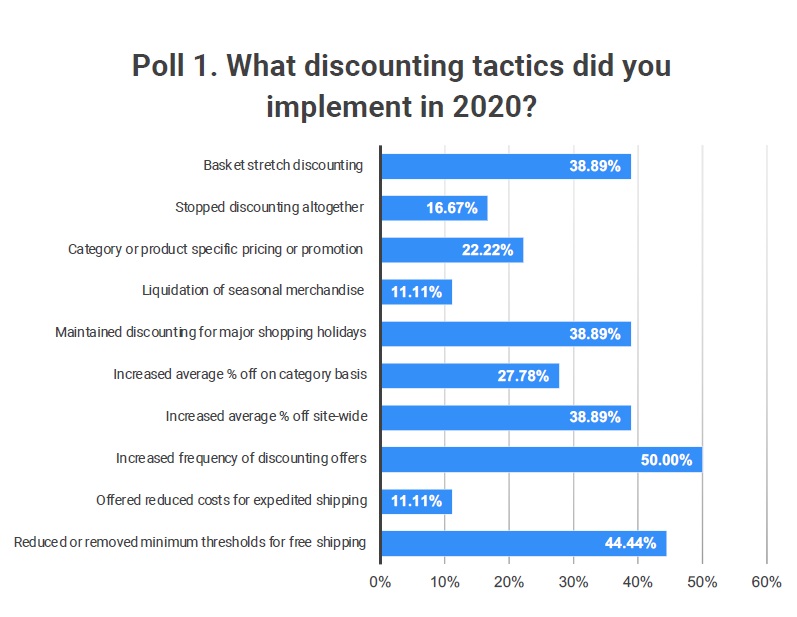
Affiliate Marketing Trend to Watch: Fundamental Shift in Consumer Behavior
McKinsey have been tracking consumer sentiment and behavior across 45 countries to determine the true impact the coronavirus pandemic is having.
Consumer sentiment varies greatly across countries impacted by COVID-19. Consumers in the APAC region consistently report higher optimism than the rest of the world, while those in Europe remain less optimistic about their countries’ economic conditions after COVID-19.
Optimism has declined throughout European countries, in line with the rise in confirmed Covid cases since late July 2020.

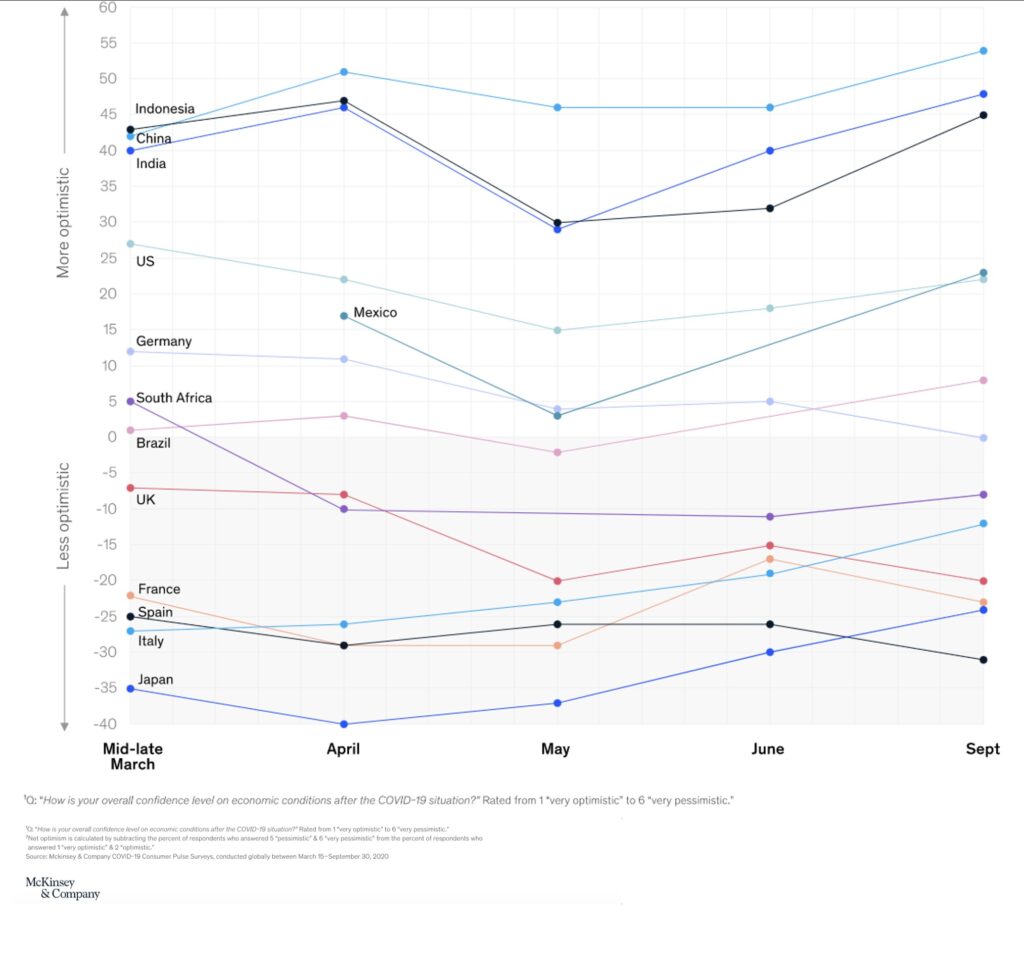
Coupled with this lowered optimistic sentiment, McKinsey identified that at the end of Sept 2020, for most categories, consumers purchase intent had also lowered.
Given how situations have developed in Europe since the end of September, this has likely escalated the situation in Q4 and into 2021. However, on a more positive note it’s great to see the increasing purchase intent increasing across many verticals in the APAC region, casting light that there is a recovery period to be had in the hopefully, not too distant future.
It is unsurprising that for right now, brands have followed these trends and developed discounting tactics to appeal to consumers’ new sense of conservatism and search for value.
But we must remember that value can have more than one interpretation.

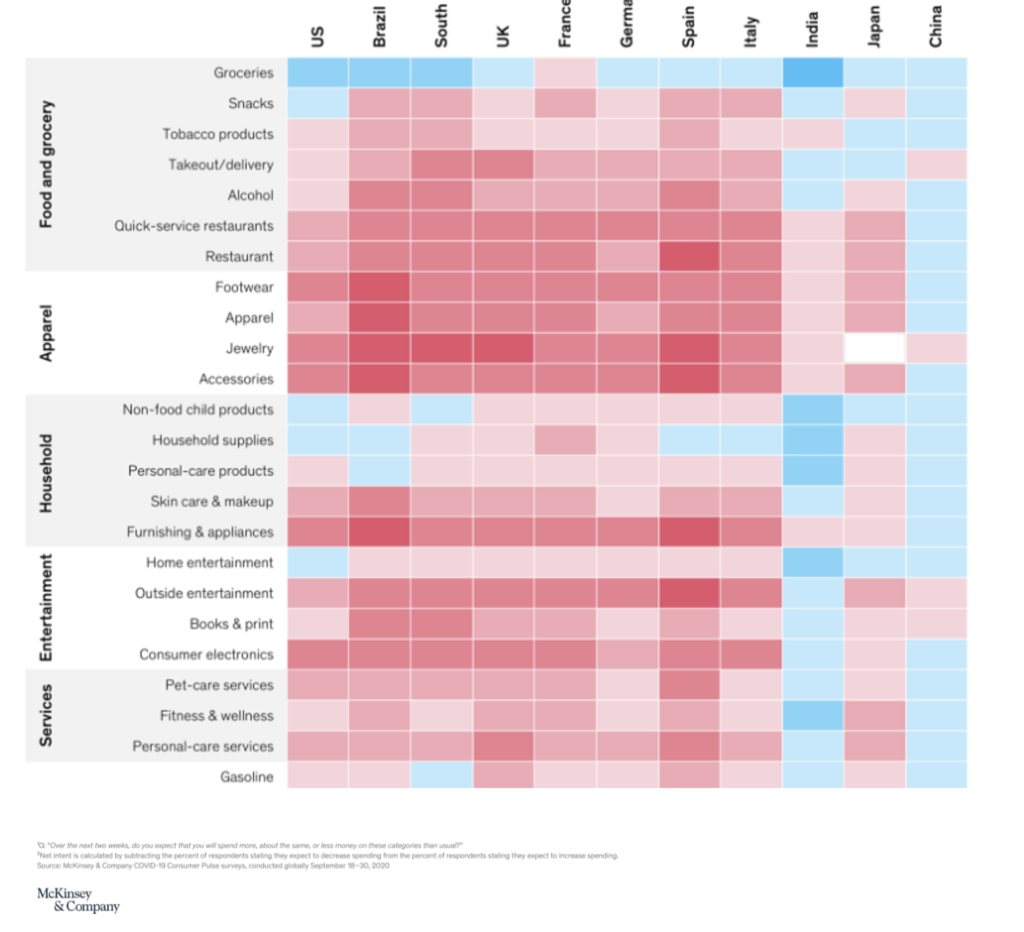
Aside from the obvious value that relates to price sensitivity, convenience and availability are most often cited as top drivers of consumers’ decisions about where to shop, while quality and purpose are the more important considerations when choosing NEW brands. This is a really interesting finding, as many brands find that lowering the value in terms of price via discounts can often drive down perceived quality of goods, whilst also having a negative impact on their bottom line.
Take for example fast-fashion brands. Last year they went crazy with their Black Friday discounts, with some offering items of clothing at prices lower than shipping costs! The response they received and publicity it caused has seen many having to justify the levels of discounts. Finding the balance between discounting, maintaining your brand perception and regarded quality can prove to be challenging.
This ploy may drive a one-off purchase but does little for brand loyalty and can only help somewhat in increasing AOVs. The partner channel offers brands the chance to give consumers a degree of ‘value’ without the approach of always having to rely on a sale.

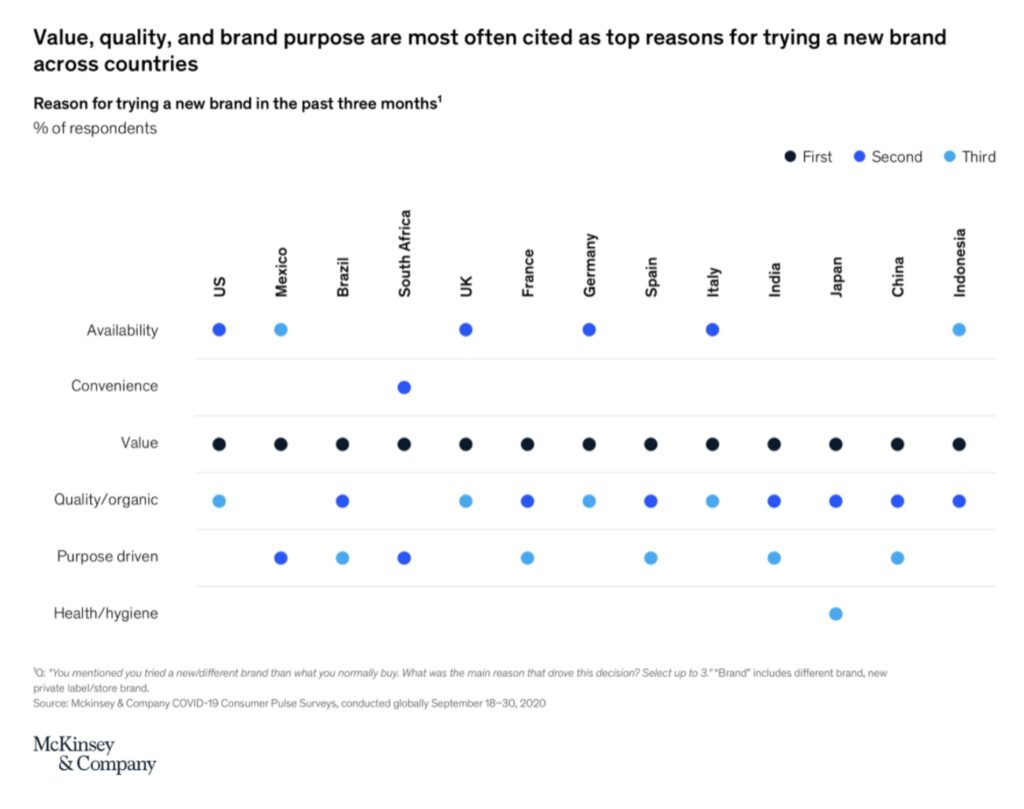
Reassuringly, across the countries observed, McKinsey found that the majority of European populations are expected to make a more significant portion of their purchases online post-Covid, than before.
When economies begin to recover and consumer purchase intent once again increases, you want to position yourself as a sought-after brand. And whilst discounting can be a part of your overall strategy and be incredibly lucrative for some, many brands should look to adapt and use it as a tactic, not the anchor, of their partner programs, Failure to do so, may see them never get off the ride.

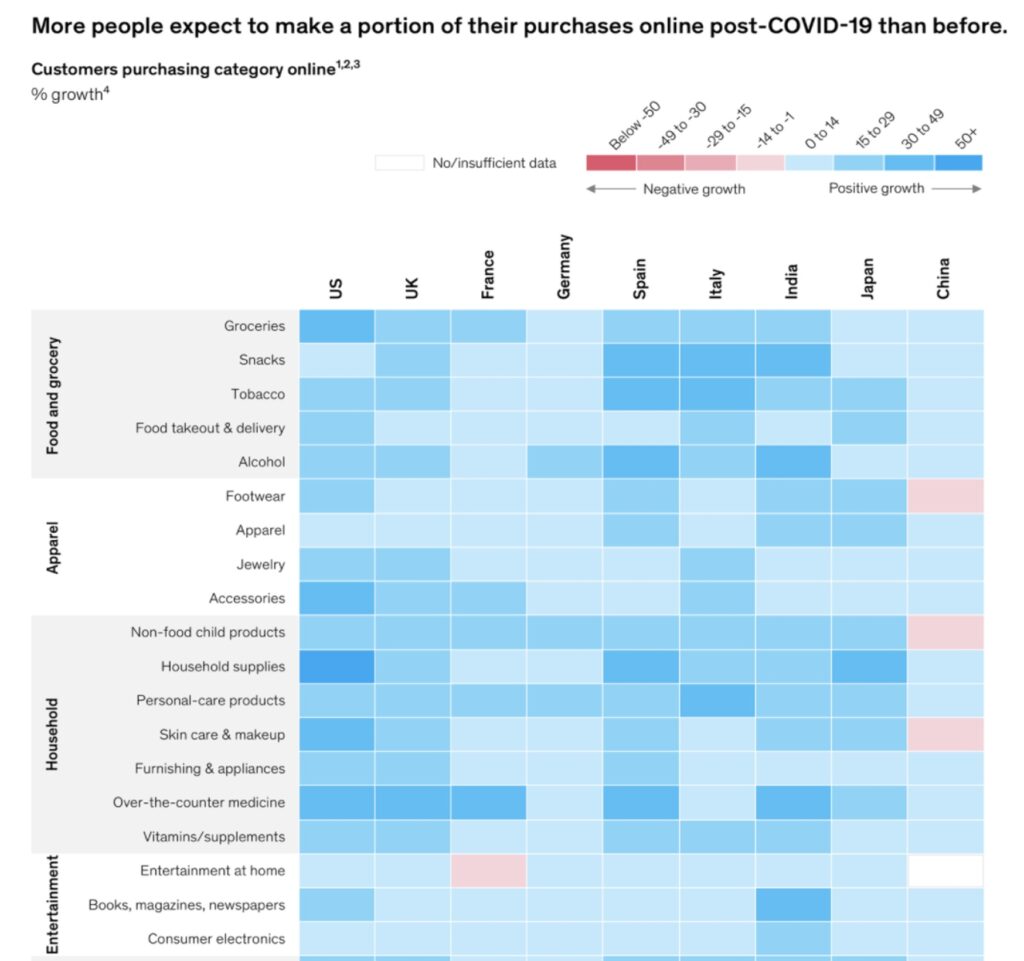
What Effects Did You Recognize Impacting Your Brands as a Result of Shifts in Consumer Behavior?
Our second poll which followed the sharing of external source data, looked to gain insight into attendees’ own experiences with consumer behavior changes in 2020. Over 66% of respondents noticed success for specific product lines which, given the limitation of normal social activities due to lockdowns, is unsurprising, for example retail brands focusing on leisure wear or products suited to home working.
Interesting to detail here is that more than 50% of respondents saw an increase in AOV, which seems to stand in direct conflict to the McKinsey report’s findings of lessening consumer purchase intent. However, there could be several contributing factors. It could be assumed that consumers were willing to spend more to gain larger discounts through some of the most popular tactics highlighted in the first poll, such as basket stretch promotions. Alternatively, it could indicate the success of offers such as free delivery in incentivizing consumers to make larger orders put perhaps less frequently.
Regardless of the full extent of reasoning behind this, it certainly makes for an interesting data source for us to draw some potential conclusions.

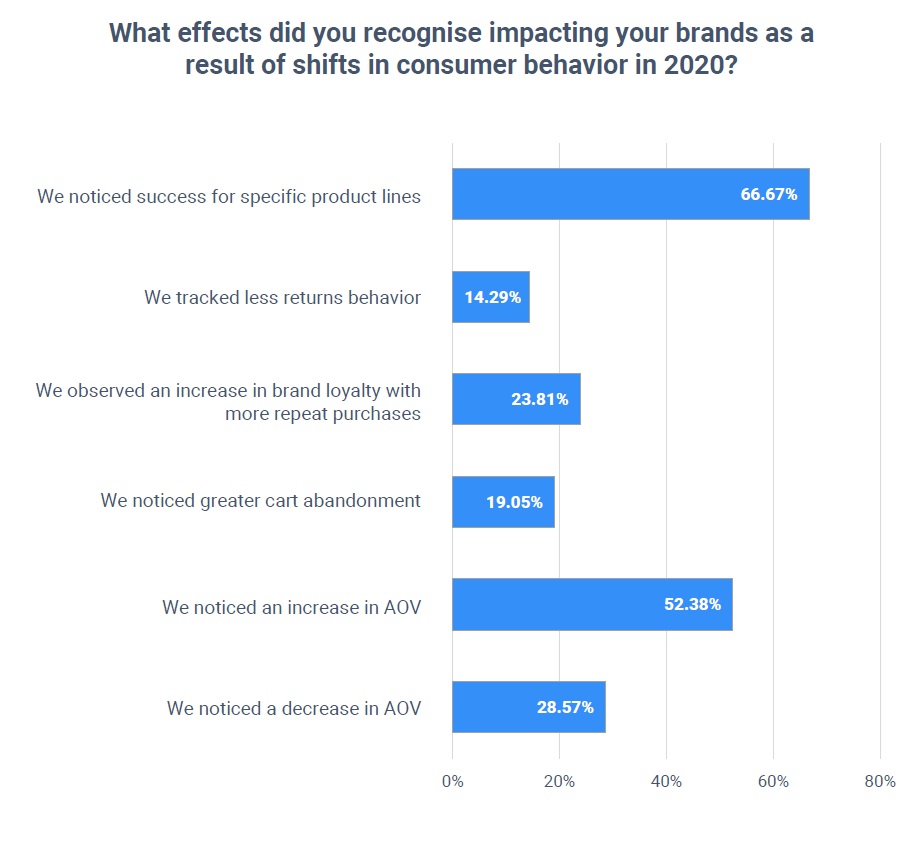
Developing Partner Landscape Trends
Something else to consider as we delve into the topic of discounting is the performance of specific partner categories during 2020. Data from the Partnerize platform reveals how the channel can be used to pivot in reaction to some of the consumer behavior trends previously highlighted. These figures are based on activity from the last 12 weeks for the EMEA region. We observed that voucher and coupon partners continue to contribute heavily to the overall performance of the channel and as such, we are not suggesting entirely moving away from discounting, simply expanding the breadth of your partnership programs and applying appropriate discounts at the right time. What we really want to look at here, is the potential for other areas of the channel to develop and provide support that bridges the gap between discounting.
As more time is spent at home, the rate of content partners is accelerating in line with this increased content consumption. Including influencers, the PZ platform saw a 37% increase in content partner sign-ups just in EMEA for the last 12 weeks. This is one of the largest increases in sign ups from any partner type and signals the willingness for consumers to engage with this partner category more than ever, hence revenue is also up 14% for these partner types. Many brands are finding that working with content, influencer and review sites is helping them tap into their motive development and research areas of the user journey, giving greater background on consumer preference from which campaigns can be tailored towards.
Interestingly, loyalty partners have also seen great performance with an 111% increase in conversions YoY. Data revealed that the order value from new customers has increased 263% from this partner category. When we describe loyalty here, we are not referring to cashback partners but instead those who offer value to the consumer through other means, for example card linked offers (CLO) or banking partners. This brilliant performance is indicative of the shift to incorporate these emerging partner types more substantially to the channel. As consumers become savvier with their finances, as we saw from some of the purchase intent data shared, they turn to these trusted sources to gain the most ‘value’ as a perk of their allegiance. As an API led tech company, Partnerize has been at the forefront of this partner category development and navigating how we can ensure these partners are rewarded appropriately.
- 37% Average increase in content partner sign ups YoY
- 14% Average increase in revenue from content partners YoY
- 111% Average increase in revenue for loyalty partners YoY
- 263% Average increase in new customer order value YoY
What Changes Did You Observe in the Affiliate Marketing Landscape, in 2020?
The final poll we took in the webinar looked to assess attendees’ observations on distinctive changes in the partnership channel in 2020.
Leading the result was the focus on new commissioning structures that move away from traditional attribution such as last click. In line with this then, it is understandable that respondents also saw an increase in content partner activity. Traditionally, this partner type is very much top of the funnel and it has been difficult to reward them accordingly in the past. However, with this increased interest and greater prolific adoption for content in the partnership realm, we are seeing more and more demand for multiple commission attribution methods.
As we can see here, a reliance on coupon/voucher partners is still very much the norm and it makes sense for brands to engage with this partner type. However, creating a diversified partner base that truly allows brands to benefit from the operating leverage of the channel and reward all partners accordingly based on contribution, is the trend we expect to see developing more so in 2022.

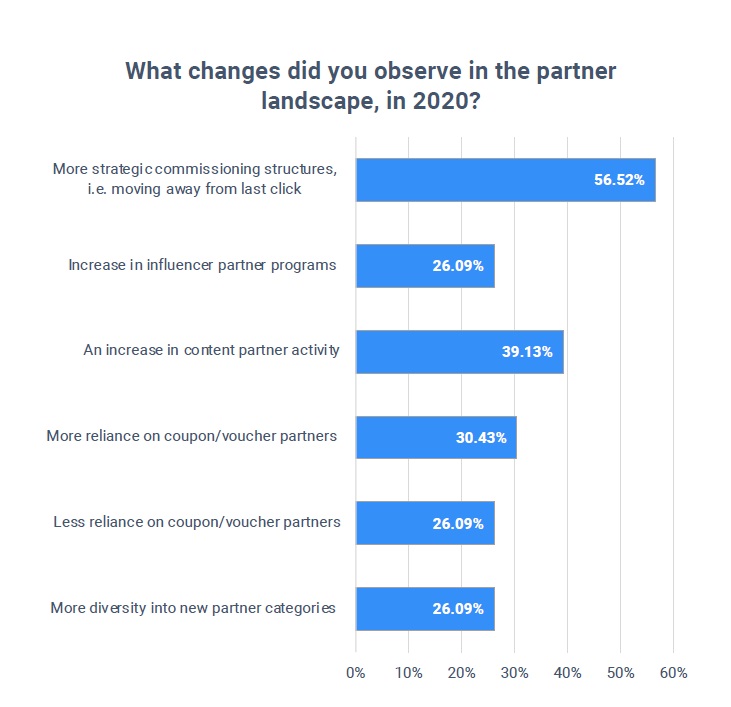
6 Excellent Tips for Improving Your Brand’s Affiliate Marketing Strategy Without Discounting
Develop a Top Down Affiliate Marketing Strategy
Already a discounted reseller of labelled brands and operating an entirely online business, MandM Direct was in an excellent position when the pandemic struck. About 5 years ago MandM made a wider business decision to move away from overlay discounting and free P&P. This shift and process of retraining the customers to not expect these deals, took nearly a year to take hold. But consequently, the business has built a solid base of fans and can now look at metrics like retention rates, which have significantly improved in parallel to their shifted focus from deal-searching consumers to customer loyalty.
One of the biggest learnings we took from our friends at MandM was the need for business buy-in to support wider market analysis. By conducting greater analysis into the wider industry, they can track activity amongst competitors during sale periods and throughout the year. They found that although they began to take less orders, they were, in fact, increasing order value which ultimately resulted in increased profits and thus proving the potential this affiliate marketing strategy has for success.
In the same regard, something for all brands to consider is reestablishing their promotional calendar. As a wider business, its key to make decisions on what shopping holidays you are actively planning to participate in and limiting these to ensure you’re not damaging the reputability of your brand. Teams can then align on how best to approach these key dates and what levers to pull to deliver the most optimal results.
Try a ‘Search Domination’ Approach
Another way to gain value from the affiliate and partner channel is by utilizing it to work alongside SEO and PPC.
Silverbean has been working with clients to initiate these programs which look to target “non brand” keywords with high search volume and strong conversion rates with publishers that have a high domain authority and organic ranking. Ultimately, this tactic has resulted in increased market share without the need for discounting.
Dominating related search terms will ensure your brand is front of mind to the consumer, and will indefinitely increase sales back to your business.
Utilize Your Wider Marketing and Insight Teams
We know that consumers don’t shop in siloes; today’s digitally connected consumer has a complex array of touchpoints requiring a more sophisticated approach that breaks down barriers. In today’s world, winning marketers and teams embrace partnerships across functions like growth and Biz Dev and PR. They know that they can tap into partnerships across the consumer research, purchase and loyalty phases, but they need a more holistic view of these interactions and to be in command of the spend or unit economics that fuel worth, and more importantly, help them meet their target audience and customers wherever they are, when they need them.
When discussing the topic of discounting with our client Browns Fashion, they raised the opportunity savvy marketers have to work with teams outside of the immediate partnership group, for example the Data and Insights and CRM teams. These really are invaluable in-house resources that you should be taking advantage of as you look to optimize and expand your partner programs.
They can highlight trends in consumer behavior that are specific to your customers and help you understand things like your key product lines that sell regardless of discounting and therefore should be kept separate of these programs. Conversely, they can help identify struggling product lines, so you can focus your programs on liquidizing this stock.
One of the most pivotal insights CRM teams can provide is their ability to offer data that looks to increase loyalty. Browns, for example, targets offers specifically for returning customers such as discounts on birthdays and develops a stream of new customer acquisition through initiatives like refer-a-friend programs. With Browns also moving entirely away from discounting two years ago, these initiatives have helped support and bridge the promotional gap.
Strengthen Comparison Shopping Services Affiliate Publishers for Activation
Similar to the tactic for search domination but specifically through the method of Google shopping, a brand can increase its share of voice through Comparison Shopping Services (CSS) results.
By working closely with your PPC team, you can identify opportunities for CSS publishers to increase your share of voice within a search term. For example, if a user searches for “YOUR BRAND + PRODUCT” you could promote both products via PPC and CSS – pushing them to specific high value product lines. This added effort towards CSS can also help you become more present in a higher number of generalist search terms, which ultimately increases brand visibility. Second to that, it might be worth utilizing these publishers to help push product/ SKU sales or categories; perhaps those ‘always on’ or best-selling products highlighted by your data and insights teams.
CSS publisher, Genie Shopping, found that Black Friday sales this year grew 271% YoY, along with a YoY revenue increase of 200% for Black Friday weekend – a 217% increase in client growth YoY. This partner type is one many brands are looking to incorporate into programs, as they can help increase category impression share on shopping without competing with your existing shopping activity and all while potentially driving highly efficient incremental sales.
Bridge the Affiliate Promotion Gap
Another key theme we identified was ‘bridging the promotional gap’. Aka finding those routes that lie between the major discounting holidays, but act as a value incentive for your consumers to increase their purchase intent.
As data showed, the Partnerize platform has seen a real boom from content partners over the past year. For many advertisers, Covid was the catalyst for content partners to become more ‘mainstream’ in affiliate, however it’s been on the radar for some time now. Content has always been known for driving a higher percentage of revenue from new customers for brands. But this has been magnified and accelerated during COVID-19 as consumers shop online more than they previously had. The trust and validity consumers associate with these partners is in turn resulting in higher order values. Content publishers are primarily “introducing” touch points vs last-click, which skews the potential rewards they arguably SHOULD see. Addressing this with strategies such as dynamic commissioning could prove invaluable in the long run.
Speaking of diversifying your partner types, there is far more that can be done in this regard to help you bridge that gap. Many of our clients are having great success with card-linked offer (CLO) partners who provide consumers value with things like discounted phone contracts (like the example featured in this image from our partner airtime rewards), or banking partners who allow consumers to build up membership points be used with retailers.
On-site conversion technology partners are also another fantastic route that can help push consumers to make that final purchase decision. These partners can increase conversions by offering free gifts at the point of purchase. They can also provide a superior level of personalization that triggers up-sell and cross-sell opportunities through an AI response which can help raise margin and tackle distressed inventory.
Consider Brand to Brand to Consumer Affiliate Partnerships
Everyone is talking B2B partnerships; but what they really mean is B2B2C, as this approach is a way for you to reach another brand’s consumers that match your consumer profile. It’s all about increasing distribution and leveraging the relationship a brand has with that consumer – i.e. trust, to recommend your brand and products.
Over the last 12- 18 months, Silverbean has been doing a lot of innovative work within the brand partnerships space. They have found that their travel and ticketing clients have led the way in brand partnerships – having explored the promise of this approach many years ago through white-labelling, APIs and auxiliary sales. This has since expanded, and the learnings from these early adoption pilot schemes are now helping agencies and tech platforms establish new ways of approaching brand to brand throughout different industries.
Most brands develop brand partnerships in order to monetize, or acquire new customers. How you execute these partnerships is between you and the other brand – it could be one-way, two-way, paid partnership etc – the key, as always, is measuring it!
Conclusion
To summarize, every partner has their place in this ecosystem. What we hope this eBook has helped you consider is balance.
Discounting has become a part of the shopping experience for many brands. It is expected. And the price sensitivity of consumers makes it a requirement for many. But what brands need to do in order to stabilize and adapt to greater competition in ecommerce, is make the level and frequency of discounting appropriate and weaved into a wider partner marketing strategy that provides value to the consumer in more ways than just a direct percentage discount.
Partnerships are a powerful alternative to other primary sales and marketing channels because it subsidizes the high costs of these channels with a pay-for outcome, not pay-for-access model. You don’t want to sacrifice these potentially lucrative outcomes with constant sales that undercut your profits.
If you want to discuss discounting models and creating a more holistic partner program, we would be delighted to hear from you. Contact us here.
Related Articles